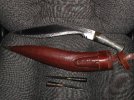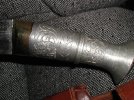- Joined
- Nov 30, 2000
- Messages
- 191
Need some help from the experts please! Can you guys help identify the country of origin, approximate date of manufacture and style of a recent purchase? Did I get a deal? Heres some additional info. Photos follow the verbage.
I purchased this beautiful Khukuri for $30 at a flea market on Saturday. The gentleman I bought it from said he was selling for his brother-in-law, who picked it up in Burma in the early 1950s. The guy looked to be in his early to late 70s. Assuming his brother-in-law is 5 years younger or older, the timeline fits chronologically. I did not challenge him about Burma being the country of origin, but thought to myself that Nepal was more likely its home country. Anyway
Before even taking the Khuk out of the sheath I admired the rather elaborate and very uniform engraving on the aluminum handle. Even the (steel) pommel has been embellished. After removing the Khuk from the sheath, I was thrilled to find hardly any rust and no pitting on the blade. I also observed what I believe are the makers original sharpening marks. Also, final polish marks were also clearly visible on the fully fullered length of the blade. Aside from the decorative engraving near the top of the blade (on both sides) I do not find any marks that hint at the maker or country of origin. The blade is straight, very uniform and evenly forged on both sides. The cutting edge is still razor sharp and the balance is perfect. I dont think this Khuk has ever been used.
The karda and chakma were still in the sheath. Unfortunately, the kardas blade was not in the same excellent condition as the Khuks. It had layer of rust on both sides and was pitted from too many years in the sheath. Despite the rust, the blade was still very sharp.
The chakma also had a layer of rust. The interesting thing about this utensil was that on close examination I found it was not just a burnisher but actually a handmade file.
The sheath color is dark British Tan. It is leather wrapped with a wood lining and a smallish brass tip. The karda and chakma compartment is stitched to the exterior as a separate pouch (the tools have separate pouches inside the larger pouch). The entire unit is very well made and in great shape! The only weak element is the frog and keeper strap. Both are made from lightweight leather and would not last long in actual field use.
After negotiating the price down a bit I bought the Khuk because the heft, balance, quality and razor sharp cutting edges screamed quality. (Besides it just would not leave my hand I guess it wanted to be adopted by someone who appreciated it).
Please tell me if you need additional info to tell me when and where this new possession was born.
I purchased this beautiful Khukuri for $30 at a flea market on Saturday. The gentleman I bought it from said he was selling for his brother-in-law, who picked it up in Burma in the early 1950s. The guy looked to be in his early to late 70s. Assuming his brother-in-law is 5 years younger or older, the timeline fits chronologically. I did not challenge him about Burma being the country of origin, but thought to myself that Nepal was more likely its home country. Anyway
Before even taking the Khuk out of the sheath I admired the rather elaborate and very uniform engraving on the aluminum handle. Even the (steel) pommel has been embellished. After removing the Khuk from the sheath, I was thrilled to find hardly any rust and no pitting on the blade. I also observed what I believe are the makers original sharpening marks. Also, final polish marks were also clearly visible on the fully fullered length of the blade. Aside from the decorative engraving near the top of the blade (on both sides) I do not find any marks that hint at the maker or country of origin. The blade is straight, very uniform and evenly forged on both sides. The cutting edge is still razor sharp and the balance is perfect. I dont think this Khuk has ever been used.
The karda and chakma were still in the sheath. Unfortunately, the kardas blade was not in the same excellent condition as the Khuks. It had layer of rust on both sides and was pitted from too many years in the sheath. Despite the rust, the blade was still very sharp.
The chakma also had a layer of rust. The interesting thing about this utensil was that on close examination I found it was not just a burnisher but actually a handmade file.
The sheath color is dark British Tan. It is leather wrapped with a wood lining and a smallish brass tip. The karda and chakma compartment is stitched to the exterior as a separate pouch (the tools have separate pouches inside the larger pouch). The entire unit is very well made and in great shape! The only weak element is the frog and keeper strap. Both are made from lightweight leather and would not last long in actual field use.
After negotiating the price down a bit I bought the Khuk because the heft, balance, quality and razor sharp cutting edges screamed quality. (Besides it just would not leave my hand I guess it wanted to be adopted by someone who appreciated it).
Please tell me if you need additional info to tell me when and where this new possession was born.



